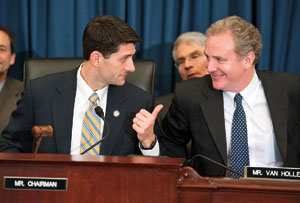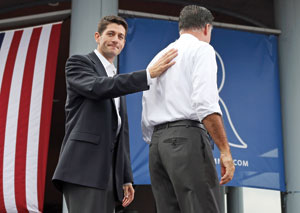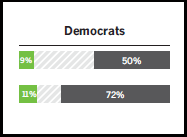CQ WEEKLY – COVER STORY
Aug. 25, 2012 – 11:12 a.m.
The Risk in the Ryan Plan
By Paul M. Krawzak, CQ Staff
When it comes to Republican presidential candidate Mitt Romney’s vice presidential pick, supporters and detractors can agree on one thing:

|
||
|
But Ryan’s approach to politics itself, from the way he has reached out to his party’s conservative wing and leadership — and even across the aisle to Democrats — to the way he has sold his detailed policy plans within Congress, has grown in sophistication as his star within Republican ranks has risen.
Putting policy substance behind party ideals has made the 42-year-old Wisconsin native an icon of the right, one who has embraced the staunchest conservatives — especially tea party newcomers — while showing them how to shape the direction of government from the inside.
Romney’s choice of Ryan as his running mate means Ryan will carry his role as a standard-bearer for the right in Congress to the national stage. But it also carries Ryan’s policy prescriptions beyond the tight partisan circles in the House for the first time, and that means Ryan’s role in the campaign carries as much risk to his own career as it does to Romney’s presidential prospects. That’s because for Ryan, there are two campaigns this year, one for the vice presidency and another for the leadership and direction of the Republican Party in the coming years.
The energy and biographical narrative Ryan brings to the ticket have been plain enough.
In contrast with Romney, whose father ran American Motors Corp. and was a Republican governor of Michigan, Ryan was raised in the more humble environment of small-town Janesville, Wis., although Ryan’s family was prominent in the town. After his father, an attorney, died of a heart attack when Ryan was only 16, the future GOP leader embraced a conservative, free-market-oriented political and economic ethic that took him to Washington as a young man. His work as an aide to Jack F. Kemp, the former House member and vice presidential candidate who was both a mentor and father figure to Ryan, set him on a path as a legislative aide and policy analyst.
Since he was first elected to the House in 1998, Ryan has pursued an agenda of scaling back the size and scope of the federal government, restructuring entitlement programs and promoting economic growth through less government intervention in the economy.
Those are the priorities he took to his position as chairman of the House Budget Committee, where he wrote budgets that include the most recent resolution, now known commonly as The Ryan Plan.
Views Remain Constant

|
||
|
Ryan’s supporters and critics alike say his passion for the budget as a tool for implementing public policy, as well as his commitment to free-market principles, have remained constant during his years in Congress.
“He expresses the same values as he did the first day,” says Patrick Louis Knudsen, who was GOP policy director of the House Budget Committee when Ryan joined the panel as a freshman and held that post until leaving to join the Heritage Foundation last year. “He laid out what he seemed to think was a mission. He hasn’t wavered from that.”
The Risk in the Ryan Plan
Democrat
“I’ve never seen him change his position,” Schwartz says. “He has been able to be much more forceful in advocating for the same agenda that he’s been fighting for more than 20 years.”
Critics point to his support during the presidency of George W. Bush of proposals to create the Troubled Asset Relief Program and a prescription drug benefit under Medicare as evidence that Ryan’s principles can bend to political tides.
But they also are evidence of his careful work within the legislative system, to follow the lead of party leadership even while pushing his own ideas closer to the mainstream.
Ryan’s greatest feat up to now has been his success in selling his budget plan, including its controversial proposal to overhaul Medicare, to sometimes-skeptical GOP leaders, as well as to the Republican rank and file in the House.
He was helped in this by a large, tea-party-backed freshman class that came to the House with the 2010 elections that gave Republicans control of the chamber.
“The Ryan budget became the tea party manifesto,” says
Republicans hope Ryan can repeat the success he enjoyed with the House GOP by persuading the electorate to support the party’s approach to spending, taxes and entitlement programs. Almost immediately upon his selection as Romney’s running mate, Ryan seemed to reorient the campaign by articulating the philosophical underpinnings of the GOP vision and taking the fight to President Obama in a way that Romney had not been able to do.
Winning the Future

|
||
|
But because Ryan is so identified with the ideas that underpin his budget, his political future rests on more than the sharp rhetoric that is expected from vice presidential candidates.
“He doesn’t have to win, but he has to come out of the campaign a winner even if he’s not vice president,” says Larry J. Sabato, director of the University of Virginia Center for Politics.
Ryan is confident the public will be open to the GOP ticket’s message.
The Risk in the Ryan Plan
“I think the people are way ahead of the political class on this issue because they know we’re on the wrong track,” Ryan said during an interview two weeks before the announcement of his selection as Romney’s vice presidential pick. “They just sort of know instinctively that politicians from both political parties — Republicans are equally to blame on this — have made a whole bunch of empty promises to people that there’s no way the government can keep.”
Ryan contends that after the election, his budget will look more mainstream as it moves through the legislative process.
“We really believe if we get through these partisan logjams we have — President Obama, the Senate — and get on to governing, and get on to fixing problems,” he said, “we can get back on to realizing what I think ought to be consensus solutions on how to tackle these problems, which have bipartisan origins.”
Ryan has already been through the process of building support for his plan.
In the weeks leading up to the adoption of Ryan’s budget earlier this year, he and House GOP leaders met repeatedly with Republican lawmakers in closed door “listening sessions” to educate members on the budget, seek input and build support.
That was strictly an intraparty effort, however, and one aimed at creating a budget resolution that Republicans could campaign on.
Sabato is skeptical that effort can be applied on a national scale. “Selling his plan or any budget plan requires a civics education lesson for the public that is beyond any politician engaging in a campaign,” Sabato says.
Still, he says the Republican ticket may neutralize the Democrats’ historic political advantage on Medicare by sowing doubt about their own proposals, as Ryan has sought to do by charging Obama’s signature 2010 health care overhaul cuts $716 billion from the program.
“All the Republicans need is a draw — all they need is a draw — on Medicare,” Sabato says.
Ryan claims “bipartisan origins” for some of the proposals in his budgets, but not a single Democrat in either chamber has voted for them.
In an effort to court Democratic support for revamping Medicare, Ryan got together with Oregon Democratic Sen.
But Wyden takes exception to the final version that appears in Ryan’s budget, which proposes replacing Medicare’s fee-for-service system with a voucher-like program referred to as “premium support.”
And Ryan and Rivlin remain at odds over the need for increasing federal revenue in addition to adopting some form of premium support system to reduce the future cost of Medicare. For Ryan, looking for common ground does not mean taxes are on the table.
The Risk in the Ryan Plan
“We believe we can get better revenues, higher revenues,” Ryan said. “But we think the secret to that is growth. Where the difference breaks down between, say, Alice [Rivlin] and myself is she’s . . . fine with targeting higher revenue in a static way, which we fear will compromise economic growth.”
In fact, to Ryan the best route to higher revenue is “through higher and faster economic growth.”
Ryan’s budget expertise has brought him clout on Capitol Hill, and looking at the evolution of his budget plans helps illustrate his political development in Congress.
This year’s budget for fiscal 2013, which Ryan called “The Path to Prosperity,” has roots that extend back to his first House term.
A Vision in a Road Map
One of his first acts as a freshman in 1999 was to introduce a resolution raising the alarm that Social Security’s costs would soon exceed its tax revenues and calling for the “strengthening” of the program, albeit without proposing specific actions. In 2004, Ryan and Sen. John E. Sununu, R-N.H., introduced an ambitious plan that would have included the potential to shift of funds to private accounts. The George W. Bush administration took up that idea in 2005 but quickly abandoned it in the face of strong opposition. Ryan in the next few years sponsored measures to cut taxes, reduce spending and expand health savings accounts.
He pulled his ideas together in an early, 2008 philosophical and fiscal manifesto. Produced less than two years after the GOP had lost control of the House, this plan proposed legislation to transform Medicare into a premium support model that would offer a tax credit to those who would buy health insurance, overhaul the tax code and establish voluntary personal savings accounts under the Social Security program.
Ryan offered a similar version of his plan, called “A Roadmap for America’s Future,” early in 2010. It drew just 14 Republican cosponsors, six more than he got the first time around. “I put this road map out there during the Bush administration, so it’s not that I don’t like
He compares the approaching debt crisis as he sees it with the war in Europe that was anticipated by Winston Churchill, one of his heroes. “That was a foreign threat he dealt with,” Ryan said. “This is an internal threat. Therefore, the solution is within our power and control, making this problem all that more solvable.”
The fiscal 2012 budget resolution that Ryan wrote last year — his first as chairman — followed his road map as a guide but veered away from some initiatives, including a revamping of Social Security, to gain consensus among GOP leaders and lawmakers.
“Now he’s writing a budget resolution for a majority, and the most important number there is 218,” says Knudsen, of the Heritage Foundation, referring to the minimum votes needed in the House to adopt a budget. “I think he took both of those budgets as far as he could and then recognized there was a point where the caucus couldn’t go any further.”
Democrats insist the shifts in Ryan’s budgets reflect an adjustment in style rather than in substance, however.
“Put it this way: same animal, different spots,” says Van Hollen, who will play Ryan for Vice President
The Risk in the Ryan Plan
For now, that means Republicans alone can be counted as sold on Ryan’s budget, and by extension on the candidate himself.
But as Ryan takes the national stage selling plans endorsed by Romney, he’ll call on the political skills he honed making his own budget the standard for Republicans in Congress. Ryan’s success this fall in winning over ordinary Americans to his vision — whether Romney wins the race for the White House or not — will tell whether his role as No. 2 on the ticket might position him as the next leader of the Republican Party.
“There are no guarantees,” Sabato says. “He might be able to use this as a springboard to national prominence for decades to come, or it could be his ticket to oblivion. No one knows.”
PAUL DAVIS RYAN
Born:Jan. 29, 1970 • Janesville, Wis.
Religion: Roman Catholic
Family: Wife, Janna Ryan • children, Liza (age 10), Charles (8) and Sam (7)
Education: Miami U. (Ohio), B.A. 1992 (political science and economics)
Career: Congressional aide to Republican Sen. Bob Kasten of Wisconsin, 1992 • speechwriter at Empower America, a conservative think tank, 1993-95 • House and Senate legislative director for Republican
Political highlights: U.S. representative, Wisconsin’s 1st District, 1999-present
Committees: Budget (chairman) • Ways and Means